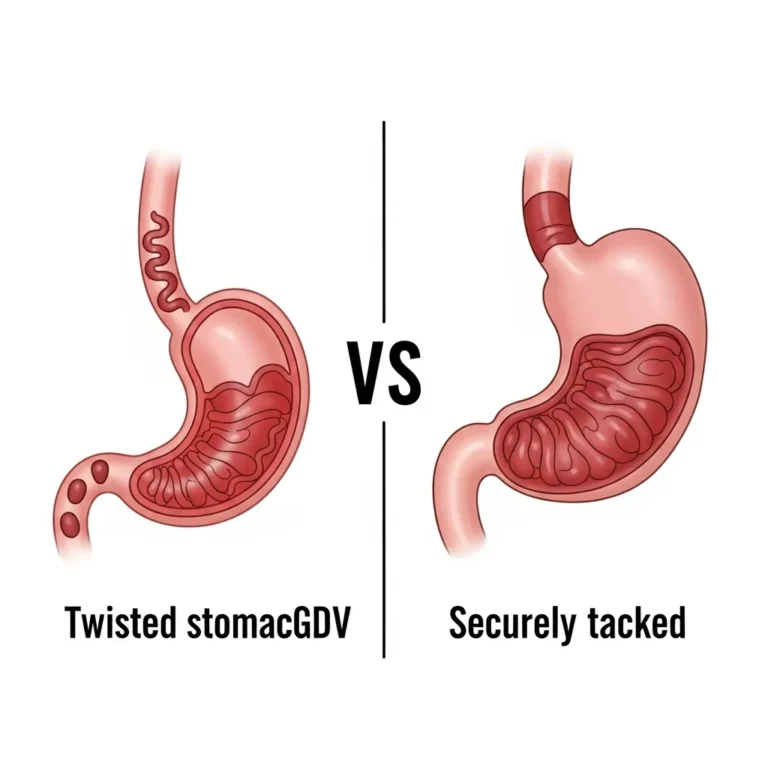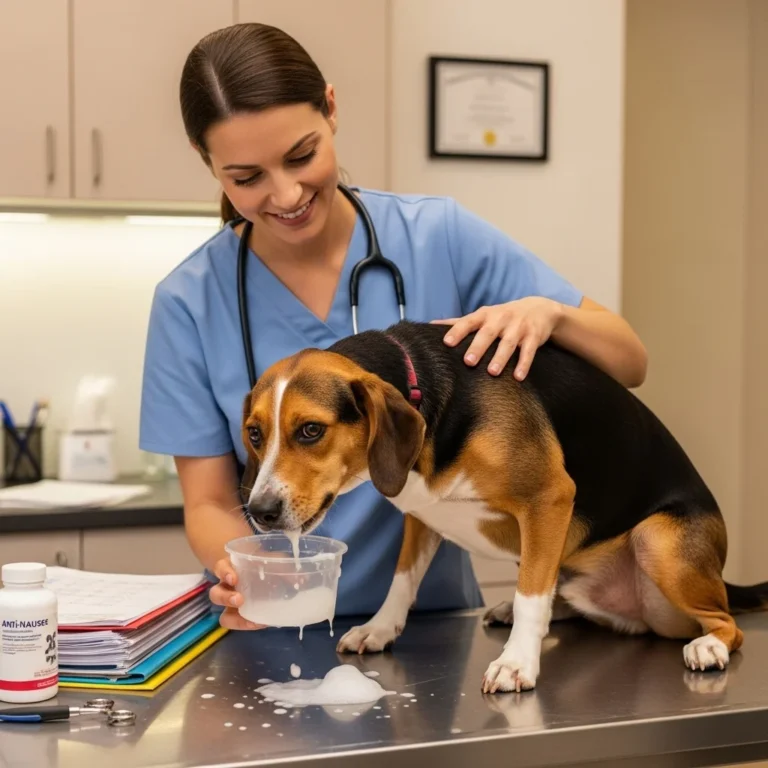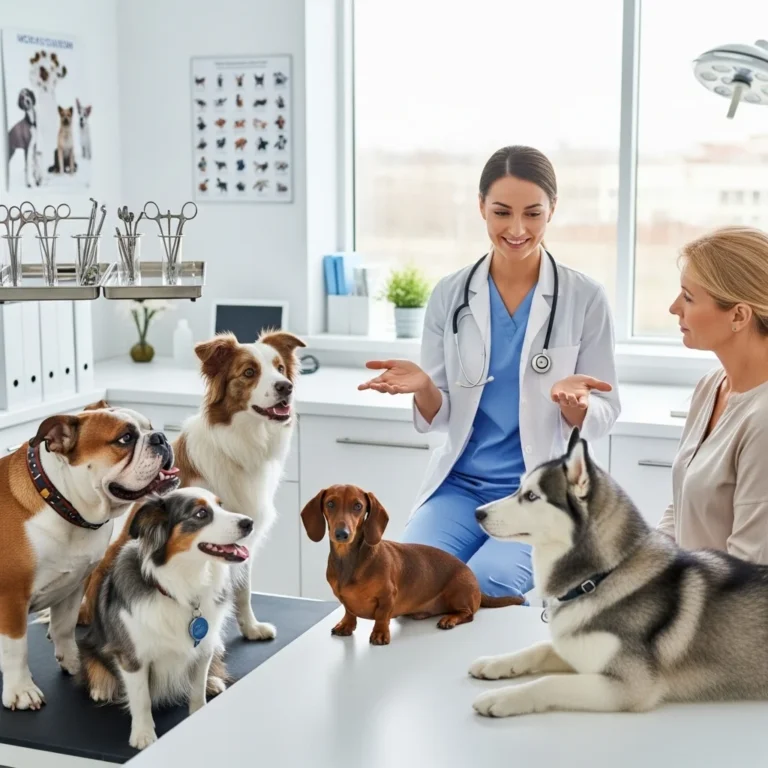
Author: DogsBlogSS Team
⚠️ Disclaimer: This article is for informational purposes only and is not a substitute for consulting a veterinarian.
gastropexy
What exactly is a gastropexy (and what does “stomach tacking” mean)?
gastropexy dog—sometimes affectionately called “stomach tacking”—is a surgical procedure where a dog’s stomach is anchored or sutured to the abdominal wall. The goal isn’t to stop the stomach from filling with gas (that’s bloat, or gastric dilatation), but to prevent it from twisting. Think of it like tying a balloon down so, even if it inflates, it can’t spin around and get tangled.
According to PetMD, during a gastropexy, the stomach is fixed in place so it can’t rotate and cause a life-threatening situation.
VCA Animal Hospitals explains that this tethering helps stop the dangerous twist known as volvulus.
What is the difference between Bloat (Gastric Dilatation) and GDV (Volvulus)?
These two terms often get used together, but they describe different (though related) problems.
- Bloat (Gastric Dilatation): This happens when the stomach fills up with gas, fluid, or food. It expands, sometimes painfully, but doesn’t necessarily twist.
- GDV (Gastric Dilatation-Volvulus): This is the much more dangerous version. After the stomach dilates, it twists on itself (volvulus), cutting off its own blood flow, and blocking both the entrance and exit. That twist is what makes GDV a life-threatening emergency.
The American College of Veterinary Surgeons (ACVS) points out that GDV can lead to shock and death very quickly if not treated.
Does gastropexy prevent bloat, or just the twisting (torsion)?
According to PetMD, Here’s a key nuance: gastropexy does not stop the stomach from bloating, but it does prevent it from twisting.
That means your dog might still have episodes of bloat, but the surgical anchor helps make sure those episodes don’t turn into the much more serious GDV.
How effective is gastropexy at saving a dog’s life if they do bloat later?
Pretty effective, actually. Research shows that when a dog undergoes gastropexy, the risk of GDV recurring drops dramatically. A review of techniques and history published in PubMed notes that proper gastropexy reduces the recurrence rate of GDV from as high as 80% to less than 5%.
That’s a big deal: once the stomach is tacked down, the life-threatening twist becomes extremely unlikely.
Is gastropexy considered a major or minor surgery?
While it’s still a surgical procedure, many vets consider prophylactic (preventive) gastropexy a relatively straightforward operation, especially compared to emergency GDV surgery. On PetMD, the risks listed are relatively mild (vomiting, infection, seroma) and rare.
Still, because it involves general anesthesia and an abdominal incision (or laparoscopic instruments), it’s not trivial—but when balanced against a life-saving potential, many owners and vets view it as worthwhile.
Part 2: Making the Decision (Risk Assessment)
This is often the heart of the matter: deciding whether your dog really needs a gastropexy.
Which breeds are statistically at the highest risk for GDV?
Deep-chested, large, or giant breeds are the biggest concern. According to the American College of Veterinary Surgeons, some of the most at-risk breeds include Great Danes, Weimaraners, Irish Setters, Gordon Setters, St. Bernards, and Standard Poodles.
PetMD also lists Great Danes, German Shepherds, Rottweilers, Irish Wolfhounds, Standard Poodles, and more.
A 2002 symposium from the AKC Canine Health Foundation emphasized that these high-risk breeds should at least be offered a gastropexy, especially during another elective surgery like spay/neuter.
Is prophylactic (preventative) gastropexy worth it for non-giant breeds?
This is where things get a bit more subjective. Evidence suggests that even for breeds that are not “giant,” but still deep-chested (like some Standard Poodles or German Shepherds), there’s a real benefit. A cost-benefit analysis published in PubMed found that for breeds like Rottweilers (lifetime risk ~3.9%) up to Great Danes (~36.7%), preventive gastropexy was cost-effective.
In other words: yes, for many non-giant but at-risk dogs, the long-term peace of mind might justify the cost.
At what age should a prophylactic gastropexy be performed?
According to AKC Canine Health Foundation, Veterinarians often recommend doing it when the dog is young, especially at the time of spay or neuter.
Doing it earlier avoids having to subject the dog to another round of anesthesia later, and the risk of complications is generally lower in healthy, younger animals.
Can an older dog still benefit from gastropexy, or is it too late?
Absolutely, older dogs can still benefit, though the decision depends on their overall health. Even if a dog is no longer a puppy, if they are in good shape and at risk for GDV, a vet may recommend gastropexy. That said, risks from anesthesia or healing may be a little higher, so a vet will weigh pros and cons carefully.
Does my dog need gastropexy if they are not a “rapid eater”?
Eating speed is just one risk factor—and not all dogs that bloat are fast eaters. According to Animal Medical Center, other factors play into GDV risk too, such as breed, temperament, and the shape of the chest.
Gastropexy helps by protecting against the twist, which is the most dangerous part, regardless of how quickly food or gas builds up.
My dog has anxiety; does that increase the need for gastropexy?
According to PubMed, Yes, possibly. Some studies and clinical opinions suggest that stress or anxiety may contribute to bloating risk.
If your dog is anxious—especially around meals, or has a high-strung temperament—your vet might lean more toward recommending a prophylactic gastropexy, since stress could exacerbate risk.
Part 3: The Procedure & Costs (Logistics)
Here’s what actually happens during surgery, and what it might cost you.
What is the difference between Laparoscopic (keyhole) and Open Gastropexy?
- According to Veterinary Care at Your Fingertips, Open Gastropexy (Incisional): The surgeon makes a larger abdominal incision, cuts matching openings in the stomach and body wall, and sutures them together. It’s tried-and-true, effective, and many vets are comfortable with it.
- Laparoscopic Gastropexy: Minimally invasive. A small camera (laparoscope) goes in through one incision, and instruments through a second. According to the Veterinary Specialty Center, this method usually takes about 35–45 minutes, leads to smaller incisions, and often results in quicker recovery.
The PubMed review of techniques also notes minimally invasive options like the grid approach, endoscopically guided, and laparoscopic—laparoscopic being the least invasive but requiring specialized skills.
Can gastropexy be performed at the same time as spay/neuter surgery?
According to AKC Canine Health Foundation,Yes, and many vets recommend doing exactly that. Elective gastropexy is often performed during spay or neuter to avoid an extra anesthesia event. Because the dog is already under anesthesia, combining surgeries makes sense, reduces overall risk, and can lower cost compared to doing them separately.
How much does prophylactic gastropexy cost compared to emergency GDV surgery?
The cost varies. According to PetMD, a non-emergency (preventative) gastropexy usually costs several hundred dollars, though it depends on the vet and whether it’s laparoscopic.
According to PetMD, In contrast, emergency surgery for GDV can easily go beyond $1,500, and when you factor in stabilization and post-op care, costs often climb to several thousand dollars.
On a relative scale, spending a few hundred (or more) now might prevent a traumatic, expensive crisis later.
Does pet insurance typically cover prophylactic gastropexy?
It depends on your policy. Some wellness plans or preventive surgery riders may cover it, while others may not. On PetMD, it’s recommended to check with your provider—especially since emergency GDV might be excluded if it’s considered a pre-existing condition.
So yes, it’s often possible, but don’t assume it’s covered—ask your insurer.
Why is laparoscopic gastropexy more expensive, and is the extra cost justified?
Laparoscopic surgery demands specialized equipment and a surgeon experienced in minimally invasive techniques. That’s part of why it’s costlier. However, many owners find the extra cost worth it because:
- According to Veterinary Specialty Center, Recovery tends to be smoother and faster.
- Smaller incisions often mean less pain, lower risk of wound complications, and less chance of scarring.
- Your dog may bounce back more quickly to normal life.
If you value faster healing and are comfortable with the surgeon’s skill level, laparoscopic gastropexy can be a very sensible choice.
Part 4: The Recovery Period (The “Real” Experience)
Okay, surgery over—but now comes what many pet parents worry about: recovery.
What does the typical recovery timeline look like (week by week)?
Here’s a rough week-by-week guide (though every dog is different):
- Days 1–3: Your dog will feel groggy from anesthesia. Appetite may be low, and they’ll probably want more rest than usual. You’ll be monitoring incisions, giving pain meds, and making sure they don’t lick or chew the stitches.
- Days 4–7: Energy returns slowly. You may see some fluid buildup (seroma) around the incision; mild swelling or a soft lump is not uncommon. Keep activity very limited.
- Week 2: Sutures or staples might come out (depending on what your vet used). Continue low-key walks only, and avoid any running, jumping, or rough play.
- Weeks 3–4: Gradually, you may let your dog increase activity, but still no full-on zoomies yet. Watch the incision site daily for redness, warmth, or discharge.
- Beyond Week 4: Many dogs are allowed back to normal life around now, but your vet’s advice is key. Long-term, they may recommend dietary changes (like feeding smaller meals) to reduce risk.
How do I keep a high-energy puppy calm for 14 days post-surgery?
A high-energy pup + 2 weeks of rest = challenge. Some strategies:
- Give them mental puzzles (food-dispensing toys, slow feeders), but keep physical exertion low.
- Schedule short, leashed walks (just for bathroom breaks).
- Provide a cozy, quiet space: crate, bed, or corner where they feel safe and calm.
- Use calming aids if your vet agrees: pheromone diffusers, gentle music, or calming supplements (under vet guidance).
What are the signs of infection or failure at the incision site?
Keep an eye out for:
- Redness, swelling, or warmth around the incision.
- Discharge or oozing (especially if it’s pus-like).
- The dog seems more painful than expected (yelping, avoiding touch).
- A foul smell from the wound.
- Lethargy, fever, or loss of appetite that persists.
If you notice any of these, call your vet immediately.
Is it normal for my dog to refuse food or act depressed for the first few days?
Yes—totally normal. After anesthesia and surgery, many dogs are off their food for a day or two. They might be tired, a little down, or disinterested. Just keep offering small, easy-to-digest meals, and follow your vet’s instructions for pain meds and feeding. If things don’t improve by day 3 or 4, check back with them.
What is a “seroma” (fluid lump), and why does it happen after this surgery?
A seroma is a soft pocket of fluid that can collect under the skin near the incision. It’s common after surgeries, including gastropexy. The body naturally produces fluid as part of healing, and if the fluid doesn’t get reabsorbed right away, it can pool into a little bump.
In many cases, seromas resolve on their own over a week or two. As long as it’s not hot, very painful, or growing rapidly, it’s usually not a sign of serious trouble.
When can my dog return to running, jumping, and rough play?
That depends on your vet’s protocol, but generally, most dogs can resume normal activity around 4 weeks after a preventive gastropexy—if their incision has healed well and your vet gives the green light.
For emergency GDV surgery (when there’s more tissue trauma), the recovery might take a bit longer, and your vet may impose tighter restrictions.
Part 5: Life After Gastropexy (Long-Term)
Once the recovery phase is over, what really changes in your dog’s life? Let’s go through the common questions and concerns.
Will gastropexy change my dog’s digestion or eating habits permanently?
Generally, no. The surgery doesn’t alter the digestive tract’s function in a way that changes how food moves through the stomach or intestines. That said, many vets will still recommend feeding smaller meals, more frequently, and avoiding overly rich or fatty diets. That’s because these habits reduce other risks—even though the twist is less of a concern now.
Can the “tack” come undone over time?
It’s rare, if properly done. According to a large study in BMC Research Notes, out of 766 dogs that had a prophylactic incisional gastropexy, only 3 dogs (0.4%) had complications at the gastropexy site (hemorrhage or minor infection).
According to PubMed, Over long-term follow-up (median ~876 days), none of the dogs in that study experienced GDV after prophylactic surgery.
In short: with good surgical technique and post-op care, the fixation tends to be durable.
Does the surgery affect my dog’s ability to vomit or burp?
Some owners worry about this, but most evidence and clinical experience suggest that gastropexy does not prevent normal vomiting or burping in routine situations. The stomach is fixed in position, but the normal function (opening and closing of sphincters, muscular contractions) generally remains intact.
If my dog bloats after a gastropexy, what are the symptoms I should look for?
Because gastropexy doesn’t stop bloat (only twisting), you still need to watch for signs of gastric dilatation. According to the ACVS, initial signs might include:
- Distended (bloated) belly
- Drooling, retching without producing anything
- According to American College of Veterinary Surgeons, Anxious posture, stretching, or looking at their abdomen
If you see these signs, it’s important to seek veterinary attention right away—even though the twist risk is much lower, bloating alone can still be dangerous.
Are there any long-term negative side effects of tacking the stomach?
According to BMC Research Notes, Based on the research, serious long-term side effects are rare. In the study of 766 dogs, very few had direct gastropexy-related complications, and none developed GDV afterward.
That said, like any surgery, there is always a small risk of infection, adhesion formation, or tissue reactions. But for many dog owners—especially those with high-risk breeds—the benefit far outweighs the risks.
Expert Voices & Advice
- According to the American College of Veterinary Surgeons (ACVS), board-certified veterinary surgeons strongly recommend gastropexy for at-risk breeds and note that GDV mortality rates can be around 15% if not treated promptly.
- A research team (de la Vega and Ralphs) published in BMC Research Notes reported very low complication rates in a large group of dogs undergoing prophylactic incisional gastropexy.
- According to PubMed, An earlier cost-benefit analysis found that preventative gastropexy could reduce mortality risk by 2.2x in Rottweilers and nearly 30x in Great Danes, making it financially and ethically sound for many high-risk breeds.
- According to the Veterinary Specialty Center, laparoscopic gastropexy is efficient (35–45 min), less invasive, and offers a smooth recovery if done by an experienced surgeon.
Final Thoughts
Deciding whether to do a canine gastropexy is deeply personal, but it’s also a decision rooted in real risk, science, and compassion. For large and deep-chested breeds—especially those with family histories of GDV—a prophylactic dog gastropexy offers a powerful layer of protection. Yes, there are costs, recovery days, and some risk. But many veterinarians and researchers agree: when you balance the relatively low risk of the procedure against the potentially fatal consequences of GDV, the scales often tip in favor of doing it early, while your dog is healthy.
Talk with your vet about your dog’s individual risk factors: breed, age, temperament, eating habits. Ask about their experience with laparoscopic versus open techniques. Consider combining the surgery with spay/neuter if that’s coming up. And if you go for it, prepare a calm, well-structured recovery plan so your pup can heal smoothly.
Your dog’s belly won’t be “untouched” anymore, but thanks to that little surgical tack, you just might spare them from a preventable, life-threatening twist.
Notice : The DogsBlogSS editorial team is dedicated to providing accurate, research-based information about dog health, behavior, and care. All our articles are fact-checked using trusted veterinary sources such as VCA Hospitals, Merck Vet Manual, and the AKC.
you may like it




